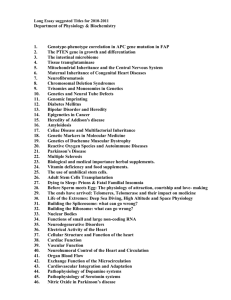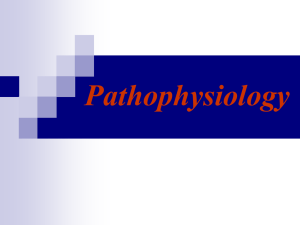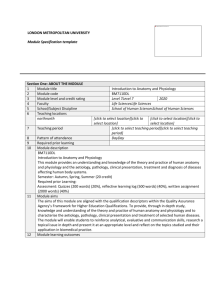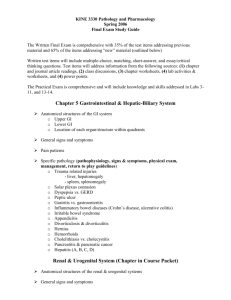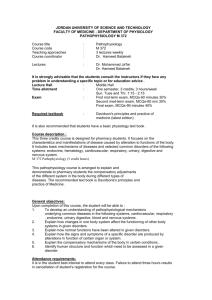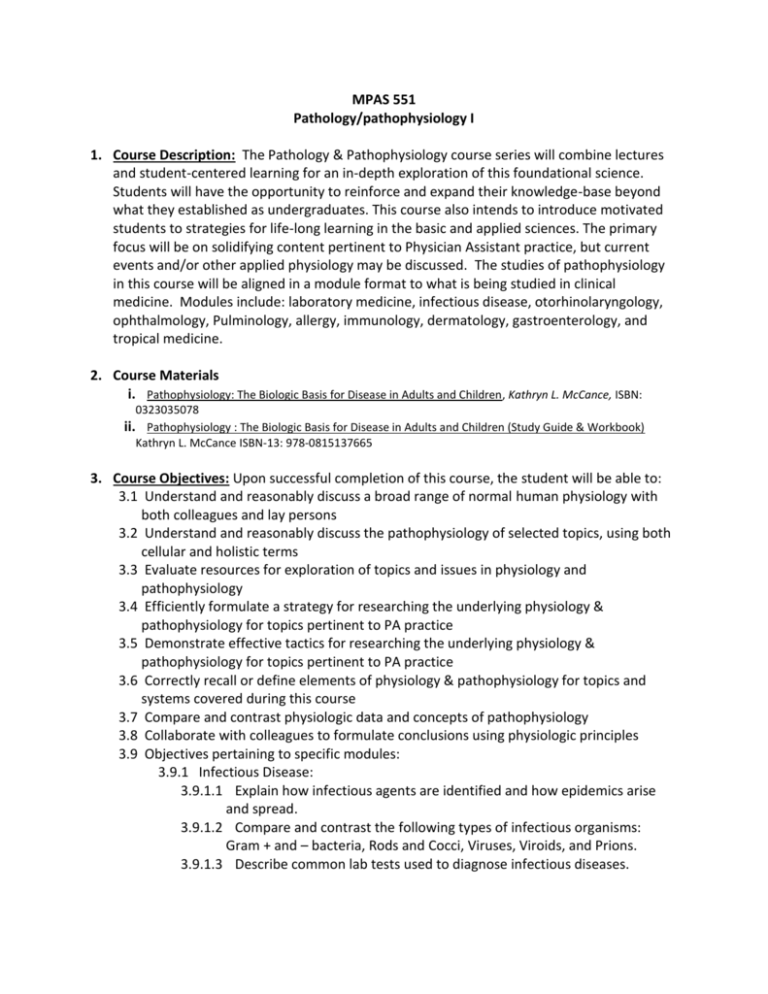
MPAS 551
Pathology/pathophysiology I
1. Course Description: The Pathology & Pathophysiology course series will combine lectures
and student-centered learning for an in-depth exploration of this foundational science.
Students will have the opportunity to reinforce and expand their knowledge-base beyond
what they established as undergraduates. This course also intends to introduce motivated
students to strategies for life-long learning in the basic and applied sciences. The primary
focus will be on solidifying content pertinent to Physician Assistant practice, but current
events and/or other applied physiology may be discussed. The studies of pathophysiology
in this course will be aligned in a module format to what is being studied in clinical
medicine. Modules include: laboratory medicine, infectious disease, otorhinolaryngology,
ophthalmology, Pulminology, allergy, immunology, dermatology, gastroenterology, and
tropical medicine.
2. Course Materials
i. Pathophysiology: The Biologic Basis for Disease in Adults and Children, Kathryn L. McCance, ISBN:
0323035078
ii. Pathophysiology : The Biologic Basis for Disease in Adults and Children (Study Guide & Workbook)
Kathryn L. McCance ISBN-13: 978-0815137665
3. Course Objectives: Upon successful completion of this course, the student will be able to:
3.1 Understand and reasonably discuss a broad range of normal human physiology with
both colleagues and lay persons
3.2 Understand and reasonably discuss the pathophysiology of selected topics, using both
cellular and holistic terms
3.3 Evaluate resources for exploration of topics and issues in physiology and
pathophysiology
3.4 Efficiently formulate a strategy for researching the underlying physiology &
pathophysiology for topics pertinent to PA practice
3.5 Demonstrate effective tactics for researching the underlying physiology &
pathophysiology for topics pertinent to PA practice
3.6 Correctly recall or define elements of physiology & pathophysiology for topics and
systems covered during this course
3.7 Compare and contrast physiologic data and concepts of pathophysiology
3.8 Collaborate with colleagues to formulate conclusions using physiologic principles
3.9 Objectives pertaining to specific modules:
3.9.1 Infectious Disease:
3.9.1.1 Explain how infectious agents are identified and how epidemics arise
and spread.
3.9.1.2 Compare and contrast the following types of infectious organisms:
Gram + and – bacteria, Rods and Cocci, Viruses, Viroids, and Prions.
3.9.1.3 Describe common lab tests used to diagnose infectious diseases.
3.9.1.4 Describe how vaccines work and differentiate those that are live and
those that are not.
3.9.2 Pulminology:
3.9.2.1 Describe the physiologic function of the pulmonary system.
3.9.2.2 Properly identify metabolic and respiratory acidosis and alkalosis when
given the results of an arterial blood gas.
3.9.2.3 Diagnose restrictive and obstructive lung disease when given the results
of a pulmonary function study and define the severity of the obstruction
or restriction.
3.9.3 Dermatology:
3.9.3.1 Describe the anatomy and physiology of the skin.
(Epidermis/Dermis/Hypodermis/Appendages)
3.9.3.2 Describe the differences anatomically and physiologically in the skin of
the following: infants and children; adolescents; pregnant women; and
older adults.
3.9.3.3 Define the following terms with regards to describing dermatologic
conditions and apply each definition appropriately when presented a
dermatologic condition:
3.9.3.3.1 Primary lesion: macule; papule; plaque; patch; nodule;
pustule; vesicle; bulla; wheal; cyst; tumor; telangiectasia.
3.9.3.3.2 Secondary lesion: scale; erosion; ulcer; fissure; crust;
erythema; excoriation; atrophy; scar; edema;
hyperpigmentation; hypopigmentation; depigmentation;
lichenification; hyperkeratosis.
3.9.3.3.3 Distribution: symmetrical vs. asymmetrical; sun exposed areas;
single or multiple; discrete; unilateral vs. bilateral;
generalized; disseminated; grouped.
3.9.3.3.4 Distinguishing characteristics: smooth; scaly; keratous;
exudative; friable; crusted; warty; umbilicated; soft; normal;
firm; hard; superficial vs. deep; color; well-circumscribed;
poorly defined; active or raised border; round; oval; irregular;
pedunculated; annular; linear; serpiginous; reticular
3.9.3.4 Describe the following special signs and tests related to dermatologic
conditions: Darier sign, Auspitz sign, Nikolsky sign, Koebner
phenomenon, patch test, and diascopy.
3.9.3.5 Describe the following nail problems: paronychia, ingrown nail,
subungual hematoma, leukonychia, onycholysis, koilonychia, beau lines,
and mucous cysts.
3.9.4 Gastroenterology:
3.9.4.1 Identify the anatomy and describe physiology of the gastrointestinal
and biliary systems.
3.9.4.2 Identify risk factors, including diet, genetics, substance abuse, and
systemic conditions, for GI and biliary pathology.
3.9.4.3 Differentiate conditions of the rectum, esophagus, stomach, small and
large intestines, and biliary tree (liver, gallbladder, pancreas, common
duct) including: dysphagia, esophageal disorders, hiatal hernia, reflux, GI
bleed, gastritis, peptic ulcer disease, malabsorption syndromes,
diverticulosis, diverticulitis, pancreatitis, GI neoplasms, anorectal
disorders, liver disease, hepatitis, gallbladder disease, irritable bowel
syndrome, inflammatory bowel disease, ulcerative colitis, and Crohn’s
disease.
3.9.4.4 Explain the pathology of infections of the GI tract to include:
gastroenteritis, colitis, food poisoning, and diverticulitis.
3.9.5 HEENT/Ophthalmology:
3.9.5.1 Describe and discuss the physiology of the ENT systems.
3.9.5.2 Describe and discuss the physiology of speech.
3.9.5.3 Identify the anatomy and describe the physiology of the eye.
3.9.5.4 Discuss defects in vision and refraction, and give examples of corrective
options.
3.9.5.5 Identify health risk factors for ophthalmologic disorders
3.9.5.6 Discuss systemic manifestations of disease found of the eye:
3.9.5.6.1 Hypertension
3.9.5.6.2 Diabetes
3.9.5.6.3 Increased intracranial pressure
3.9.5.6.4 Thyroid disease
3.9.6 Allergy and Immunology:
3.9.6.1 Define the physiology and pathophysiology of allergic response and
immunologic dysfunction.
3.9.6.2 Identify and distinguish the pathology of the different hypersensitivity
reactions.
3.9.6.3 Name the diagnostic and lab tests for allergies and immunologic
problems, and interpret the results which including: CBC, nasal smear,
RAST test, immunoglobulins, ABO/RH typing, and HLA tissue typing.
3.9.6.4 Define and differentiate autoimmune and immunodeficiency disease.
3.9.6.5 Define the immunotherapy of environmental and drug and food
allergies.
4. Student Activities and Experiences:
4.1 Faculty guided lecture
4.2 Independent reading assignments
4.3 Integrated computer technology will be utilized to enhance learning.
4.4 Independent workbook exercises
5. Assessment Techniques:
5.1 Comprehensive final examination (35% of total grade)
5.2 End of module exams (35 % of total grade)
5.3 Workbook assignments (20% of final grade)
5.4 Full attendance and participation (10% of final grade)
6. Course grades: are calculated on a percentage basis. All final course grade percentages are
rounded to the nearest integer. (XX.50% or higher is rounded up to the next higher integer.
XX.49% or less is rounded down.) Final course grades are assigned according to the
following academic standards:
Didactic & Research Courses
Percent Grade
Letter Grade
90 – 100
A
student has exceeded expectations
80 – 89
B
student has met expectations
70-79
C
student is below expectations
Less than 70
F
student has failed expectations
An “I” may be temporarily awarded to individuals who fail to complete course requirements
within the defined time. A final grade of “F” in any PA course is a non-passing grade and
results in automatic and immediate dismissal from the PA Program.
7. Tentative Schedule:
Module Lecture topics
Intro to health care
and laboratory
medicine
Infectious Disease
Otorhinolaryngology
Ophthalmology
Pulminology
Allergy and
Immunology
Dermatology
Genetics
Gastroenterology
Dates
Lecture and case study
Jan 15-21
Introduction to human
pathophysiology
Jan 22-Feb 5
Feb 8-17
Feb 18-25
Feb26-March10
March 11-26
March 29-April 7
April 8-9
April 10-22
April 30
The Pathology and physiology of
Infectious Disease
The Pathology and physiology of
Otorhinolaryngology
The Pathology and physiology of
Ophthalmology
The Pathology and physiology of
Pulminology
The Pathology and physiology of
Allergy and Immunology
The Pathology and physiology of
Dermatology
The Pathology and physiology of
Genetics
The Pathology and physiology of
Gastroenterology
Cumulative Final
8. Academic Honesty Policy : At a Christian liberal arts university, committed to the pursuit of
truth and understanding, any act of academic dishonesty is especially distressing and
cannot be tolerated. In general, academic dishonesty involves the abuse and misuse of
information or people to gain an undeserved academic advantage or evaluation. The
common forms of academic dishonesty include:
8.1. Cheating: using deception in the taking of tests or the preparation of written work,
using unauthorized materials, copying another person’s work with or without consent,
or assisting another in such activities;
8.2. Lying: falsifying fabricating, or forging information in either written or spoken
presentations;
8.3. Plagiarism: using the published writings, data, interpretations of ideas of another
without proper documentation
Episodes of academic dishonesty are reported to the Vice President for Academic Affairs.
The potential penalty for academic dishonesty includes
1.) a failing grade on a particular assignment
2.) a failing grade for the entire course
3.) charges against the student with the appropriate disciplinary body
9. ADA Statement: In accordance with Americans with Disabilities Act, any student in this
class who has a documented learning disability will be provided with treasonable
accommodations designed to meet his/her needs. Before any such assistance can occur, it is
the responsibility of the student to see that documentation is on file with Academic Affairs.
I you have documented special needs you must make them known to the instructor prior to
the third week of class
10. Emergency Contact: All cell phones and pagers need to remain OFF during lectures and
labs, Monday through Friday. If someone needs to reach you during that time, the
administrative assistant for the program will take any important phone messages.
MPAS 552
Pathology/Pathophysiology II
1.
Course Description: Students will learn integrative human physiology and pathophysiology
involving the cardiological, hematological, oncological, neurological, and psychological
systems with an emphasis upon homeostatic mechanisms and the etiologies of disease
states. Recognition of the interrelationship of function and dysfunction at the molecular,
cellular and tissue levels, as well as the organ and systemic levels provides the student
with the necessary foundation for MPAS 542 and 543 (Clinical Medicine II and III).
2.
Course Materials:
i) Pathophysiology: The Biologic Basis for Disease in Adults and Children, Kathryn L. McCance, ISBN:
0323035078
ii) Pathophysiology : The Biologic Basis for Disease in Adults and Children (Study Guide & Workbook)
Kathryn L. McCance ISBN-13: 978-0815137665
3. Course Objectives: Upon successful completion of this course, the student will be able to:
3.1 Identify the normal physiology involving the systems studied.
3.2 Analyze the relationship between normal physiology and the disruption of the homeostatic
equilibrium produced by disease processes the systems studied.
3.3 Differentiate the pathophysiology of various disease processes involving the systems
studied.
3.4 Select treatment strategies for specific disease processes involving the systems studied
based upon fundamental physiological principles.
3.5 Select appropriate diagnostic procedures specific to the organ system based upon the
students understanding of the pathological basis of disease.
3.6 Correctly recall or define elements of physiology & pathophysiology for topics and systems
covered during this course
3.7 Compare and contrast physiologic data and concepts of pathophysiology
3.8 Collaborate with colleagues to formulate conclusions using physiologic principles
3.9 Discuss the Pathology and physiology of shock, multiple organ failure, and burns.
3.10 Objectives pertaining to specific modules:
3.10.1 Hematology/oncology:
3.10.1.1 Describe each of the following anemias with regard to etiology and
pathophysiology. Catagorize each as microcytic, normocytic or macrocytic.
3.10.1.1.1
Aplastic
3.10.1.1.2
Vitamin B12 deficiency
3.10.1.1.3
Folate deficiency
3.10.1.1.4
Iron deficiency
3.10.1.1.5
G6PD deficiency
3.10.1.1.6
Hemolytic
3.10.1.1.7
Sickle cell
3.10.1.1.8
Thallassemia
3.10.1.1.9
Myxedema
3.10.1.1.10
Myelodysplasia
3.10.1.2 Discuss and differentiate the etiology and pathology of the following:
3.10.1.2.1
aplastic anemia
3.10.1.2.2
neutrophilia (primary and secondary)
3.10.1.2.3
neutropenia
3.10.1.2.4
eosinophilia
3.10.1.2.5
lymphocytosis
3.10.1.3 Describe and discuss the pathophysiology of the following disorders:
polycythemia, lymphadenopathy, lymphocytic leukemia, myelogenous leukemia,
lymphomas, multiple myeloma, and Hodgkin’s disease.
3.10.1.4 Describe and discuss the pathophysiology of the following disorders of
hemostasis: Idiopathic thrombocytopenic purpura, thrombotic thrombocytopenic
purpura, coagulopathies, factor VIII disorders, factor IX disorders, factor XI
disorders, thrombocytopenia, Von Willebrand’s disease, vitamin K deficiency,
disseminated intravascular coagulation, thrombocytosis, thrombosis, HEELP
syndrome, and platelet disorders.
3.10.1.5 Describe and discuss the various reactions that can occur during or after
a blood transfusion.
3.10.1.6 When given the appropriate information, demonstrate the ability to
stage a cancer using the TNM method.
3.10.1.7 Demonstrate understanding of how tumor size and tumor markers are
used to evaluate the effectiveness of treatment.
3.10.2 Geriatrics:
3.10.2.1 Recognize those physiologic and anatomic changes that occur in the
aging process, being able to differentiate between those findings that are
considered normal in aging and those that are pathologic.
3.10.3 Psychology:
3.10.3.1 Discuss and describe the pathophysiologic components of common
psychiatric illnesses.
3.10.4 Neurology:
3.10.4.1 Identify the anatomy and describe the physiological mechanisms of the
neurological system.
3.10.4.2 Describe and discuss the pathology of common neurologic problems
including: multiple sclerosis, neuropathies, spinal disc disease, CNS trauma,
Alzheimer’s disease, cerebral palsy, Bell's palsy, peripheral neuropathy, GuillainBarre syndrome, myasthenia gravis, cluster headache, migraine headache, tension
headache, encephalitis, meningitis, essential tremor, Huntington’s disease,
Parkinson’s disease, seizure disorders, muscular dystrophy, amyotrophic lateral
sclerosis, and space occupying lesions.
3.10.5 Cardiology:
3.10.5.1 Identify the anatomy of the cardiovascular system; describe the
physiology and dynamics of pressure, electrical impulse pathways, and correlate
this knowledge with clinical conditions.
3.10.5.2 Evaluate and trace through the cardiac cycle, cardiac murmurs of aortic
stenosis/regurgitation, pulmonic stenosis/regurgitation, mitral
stenosis/regurgitation, tricuspid stenosis/regurgitation, atrial septal defect,
ventricular septal defect, and aortic coarctation, and describe the course,
hemodynamic effect and typical clinical findings of these conditions.
3.10.5.3 Explain the pathophysiology and clinical presentations of the following
conditions: Atherosclerosis, acute myocardial infarction, angina, atrial fibrillation,
atrial flutter, atrioventricular block, bundle branch block, premature
supraventricular tachycardia, premature beats, ventricular tachycardia, ventricular
fibrillation, hypertension, hyperlipidemic disorders, congestive heart failure, cor
pulmonale, cardiomyopathies, myocarditis, pericarditis, aneurysms, dissections of
the aorta, carotid artery stenosis, endocarditis, rheumatic fever, peripheral
vascular disease, intermittent claudication, deep venous thrombosis, chronic
venous stasis, varicosities, phlebitis, pulmonary hypertension, congenital heart
disorders, pulmonary stenosis, coarctation of the aorta, atrial septal defect, patent
foramen ovale, ventricular septal defect, tetralogy of Fallot, and patent ductus
arteriosus.
4.
Student Activities and Experiences:
4.1 Faculty guided lecture
4.5 Independent reading assignments
4.6 Independent workbook exercises
4.7 Integrated computer technology will be utilized to enhance learning.
5.
Assessment Techniques:
5.5 Comprehensive final examination (35% of total grade)
5.6 End of module exams (35 % of total grade)
5.7 Workbook assignments (20% of final grade)
5.8 Full attendance and participation (10% of final grade)
6.
Course grades: are calculated on a percentage basis. All final course grade percentages
are rounded to the nearest integer. (XX.50% or higher is rounded up to the next higher
integer. XX.49% or less is rounded down.) Final course grades are assigned according to
the following academic standards:
Didactic & Research Courses
Percent Grade
Letter Grade
90 – 100
A
student has exceeded expectations
80 – 89
B
student has met expectations
70-79
C
student is below expectations
Less than 70
F
student has failed expectations
An “I” may be temporarily awarded to individuals who fail to complete course requirements
within the defined time. A final grade of “F” in any PA course is a non-passing grade and
results in automatic and immediate dismissal from the PA Program.
7.
Tentative Schedule:
Module
Cardiology
Hematology
Oncology
Neurology
Psychology
CAM and Occupational
Medicine
Geriatrics
Rehabilitation and end
of life care
Dates
May 10-June 4
June7-15
June16-24
June25-July 9
July 12-24
July 25-26
July 27-August 6
August 9-11
August 13
8.
Lecture and case study topics
The Pathology and physiology of
cardiology
The Pathology and physiology of
hematology
The Pathology and physiology of
oncology
The Pathology and physiology of
Neurology
The Pathology and physiology of
Psychiatry
The Pathology and physiology of
Shock
The Pathology and physiology of
multiple organ failure
The Pathology and physiology of
burns
Cumulative Final
Academic Honesty Policy : At a Christian liberal arts university, committed to the
pursuit of truth and understanding, any act of academic dishonesty is especially
distressing and cannot be tolerated. In general, academic dishonesty involves the abuse
and misuse of information or people to gain an undeserved academic advantage or
evaluation. The common forms of academic dishonesty include:
a. Cheating: using deception in the taking of tests or the preparation of written
work, using unauthorized materials, copying another person’s work with or
without consent, or assisting another in such activities.
b. Lying, falsifying fabricating, or forging information in either written or spoken
presentations.
c.
Plagiarism: using the published writings, data, interpretations of ideas of another
without proper documentation
Episodes of academic dishonesty are reported to the Vice President for Academic Affairs.
The potential penalty for academic dishonesty includes:
1.) A failing grade on a particular assignment
2.) A failing grade for the entire course
3.) Charges against the student with the appropriate disciplinary body
9.
ADA Statement: In accordance with Americans with Disabilities Act, any student in this
class who has a documented learning disability will be provided with treasonable
accommodations designed to meet his/her needs. Before any such assistance can occur,
it is the responsibility of the student to see that documentation is on file with Academic
Affairs. If you have documented special needs you must make them known to the
instructor prior to the third week of class.
10.
Emergency Contact: All cell phones and pagers need to remain OFF during lectures and
labs, Monday through Friday. If someone needs to reach you during that time, the
administrative assistant for the program will take any important phone messages.
MPAS 553
Pathology/Pathophysiology III
1. Course Description: Students will learn integrative human physiology and pathophysiology
involving the endocrine, nephrological, urological, gynecological, rheumatological, and
orthopedic systems with an emphasis upon homeostatic mechanisms and the etiologies
of disease states.
2.
Course Materials:
i) Pathophysiology: The Biologic Basis for Disease in Adults and Children, Kathryn L. McCance, ISBN:
0323035078
ii) Pathophysiology : The Biologic Basis for Disease in Adults and Children (Study Guide & Workbook)
Kathryn L. McCance ISBN-13: 978-0815137665
3.
Course Objectives: Upon successful completion of this course, the student will be able
to:
3.1 Understand and reasonably discuss a broad range of normal human physiology with
both colleagues and lay persons
3.2 Understand and reasonably discuss the pathophysiology of selected topics, using
both cellular and holistic terms
3.3 Evaluate resources for exploration of topics and issues in physiology and
pathophysiology
3.4 Efficiently formulate a strategy for researching the underlying physiology &
pathophysiology for topics pertinent to PA practice
3.5 Demonstrate effective tactics for researching the underlying physiology &
pathophysiology for topics pertinent to PA practice
3.6 Correctly recall or define elements of physiology & pathophysiology for topics and
systems covered during this course
3.7 Compare and contrast physiologic data and concepts of pathophysiology
3.8 Collaborate with colleagues to formulate conclusions using physiologic principles
3.9 Objectives pertaining to specific modules:
3.9.1 Endocrine:
3.9.1.1 Identify the endocrine anatomy and describe the physiological
mechanisms of the endocrine system.
3.9.1.2 Differentiate and define the pathology of conditions of the
hypothalamus and pituitary gland, thyroid gland, thymus gland,
ovaries, testes, parathyroid gland, bones and adrenal cortex.
3.9.2 Nephrology:
3.9.2.1 Identify the anatomy of the nephron and gross renal
structures.
3.9.2.2 Describe the physiology of the kidney pertaining to the organ’s
role in maintaining acid-base balance, fluid and electrolyte
maintenance, and hemodynamic status.
3.9.2.3 Differentiate between nephritic and nephrotic syndromes.
3.9.2.4
Explain the pathophysiology and clinical presentations of the
following conditions: acid-base disorders, fluid and electrolyte
disturbances, renal failure, interstitial nephritis,
glomerulonephritis, chronic renal insufficiency,
glomerulonephropathies, tubulointerstitial disease, cystic
diseases of the kidney, nephrolithiasis, and renal artery stenosis.
3.9.3 Urology and men’s health:
3.9.3.1 Identify and describe the clinically relevant anatomy most
pertinent to male sexual functioning.
3.9.3.2 Describe and relate the continuum of normal sexual
development in males.
3.9.3.3 Describe normal sexual function including the sexual response
cycle, distinguishing gender differences, and the changes that
take place through the lifespan.
3.9.3.4 Describe and explain the pathophysiology of chromosomal and
hormonal disorders of sexual differentiation including: Turner
syndrome, Klinefelter syndrome, androgen insensitivity
syndrome, and congenital adrenal hyperplasia.
3.9.3.5 Identify and explain the pathophysiology for the following
disorders of sexual function: Inhibited sexual desire, arousal
phase disorders, orgasmic phase disorders, priapism, phimosis,
paraphimosis, hypospadias, and epispadias.
3.9.3.6 Describe the anatomy and physiology of the male genitorurinary tract.
3.9.3.7 Describe and interpret laboratory tests to include: UA, dipstick
and microscopic, PSA, Urethral swab for STD, Tests for testicular
cancer including follow-up tests—FSH, LH, HCG, and Semen
analysis.
3.9.3.8 Identify and describe the pathophysiology of the following:
UTI, cystitis, prostatitis, incontinence, BPH, urinary outlet
obstruction, epididymitis, orchitis, testicular torsion, penile
disorders, hernia, and hydrocele.
3.9.3.9 Define erectile dysfunction and sexual dysfunction of males
and describe the appropriate evaluation and treatment.
3.9.3.10 Describe the pathophysiology of various types of genitourinary tumors including: Prostate cancer, penile cancer,
testicular tumors, and bladder tumors.
3.9.4 OBGYN and women’s health:
3.9.4.1 Identify and describe the clinically relevant anatomy pertinent
to female sexual functioning.
3.9.4.2 Describe and relate the continuum of normal sexual
development in females.
3.9.4.3
Describe normal sexual function including the sexual response
cycle, distinguishing gender differences, and the changes that
take place through the lifespan.
3.9.4.4 Describe and explain the pathophysiology of chromosomal and
hormonal disorders of sexual differentiation including: Turner
syndrome, Klinefelter syndrome, androgen insensitivity
syndrome, and congenital adrenal hyperplasia.
3.9.4.5 Identify and explain the pathophysiology for the following
disorders of sexual function: Inhibited sexual desire, arousal
phase disorders, orgasmic phase disorders, dyspareunia, and
vaginismus.
3.9.4.6 Recall the anatomy and physiology unique to the female
genitourinary tract.
3.9.4.7 Recall from Infectious Disease module pathophysiology of the
sexually transmitted diseases and discuss prevention.
3.9.4.8 Explain the pathology and physiology of the following:
3.9.4.8.1 Menstrual disorders: amenorrhea, oligomenorrhea,
menorrhagia, metrorrhagia, dysmenorrheal,
dysfunctional uterine bleeding, premenstrual
syndrome and premenstrual dysphoric disorder.
3.9.4.8.2 Breast disorders: Benign breast diseases (cysts/
/fibroadenoma/mastitis) and breast cancers.
3.9.4.8.3 Menopause and perimenopausal osteoporosis
3.9.4.9 Explain the pathophysiology of diseases of the female external
genital tract and vagina, to include: Sexually transmitted
diseases, vaginal candidiasis, bacterial vaginosis, trichomoniasis,
dermatologic problems of the vulva, malignancy, bartholin’s
cysts, and abscess.
3.9.4.10 Explain the pathophysiology of the following disorders of the
uterus, fallopian tubes, and ovaries: Endometriosis,
adenomyosis, endometritis, leiomyoma/fibroids, pelvic
inflammatory disease, ovarian torsion, ectopic and molar
pregnancy, ovarian cysts, and polycystic ovarian syndrome.
3.9.4.11 Explain healthy female fertility and explain the presentation,
risk factors, physiology, and pathology of infertility.
3.9.4.12 Describe the pathophysiology of the following gynecologic
cancers: Vulvar, vaginal, cervical, uterine, endometrial, and
ovarian.
3.9.5 Pediatrics:
3.9.5.1 Identify familial, genetic and systemic disorders that can cause
growth abnormalities in children.
3.9.5.2 Describe the nutritional needs of infants through adolescents.
3.9.5.3 Discuss and contrast theories of childhood development.
3.9.5.4
Describe the pathophysiology of the common causes of
childhood morbidity and mortality.
3.9.5.5 Identify the common dermatoses seen in childhood and
adolescence and describe the related pathophysiology.
3.9.6 Rheumatology:
3.9.6.1 Describe and discuss various pathophysiologic processes
related to rheumatological disorders.
3.9.7 Orthopedics:
3.9.7.1 Describe and identify the anatomy and physiology of the
human musculoskeletal system.
3.9.7.2 Describe and recognize the pathophysiology of common
orthopedic disorders including; plantar fasciitis, fractures,
dislocations, sprains, strains, tendonitis, patellofemoral
syndrome, bursitis, Osgood-Schlatter disease, ligament injuries,
meniscal injury, slipped capital femoral epiphysis, avascular
necrosis, low back pain, scoliosis, torticollis, spondylolisthesis,
herniated nucleus pulposis, cauda equine syndrome, spinal
stenosis, rotator cuff injuries, Impingement syndromes,
acromioclavicular separation, radial head subluxation,
epicondylitis, carpal tunnel syndrome, ganglion cyst, Dupuytren’s
syndrome, DeQuervain’s disease, trigger finger, mallet finger,
and Infectious disorders (septic joint, osteomyelitis, paronychia,
felon, tenosynovitis).
4.
Student Activities and Experiences:
4.1 Faculty guided lecture
4.2 Independent reading assignments
4.3 Independent workbook exercises
4.4 Integrated computer technology will be utilized to enhance learning.
5.
Assessment Techniques:
5.9 Comprehensive final examination (35% of total grade)
5.10 End of module exams (35 % of total grade)
5.11 Workbook assignments (20% of final grade)
5.12 Full attendance and participation (10% of final grade)
6.
Course grades: are calculated on a percentage basis. All final course grade percentages
are rounded to the nearest integer. (XX.50% or higher is rounded up to the next higher
integer. XX.49% or less is rounded down.) Final course grades are assigned according to
the following academic standards:
Didactic & Research Courses
Percent Grade
Letter Grade
90 – 100
A
student has exceeded expectations
80 – 89
B
student has met expectations
70-79
C
student is below expectations
Less than 70
F
student has failed expectations
An “I” may be temporarily awarded to individuals who fail to complete course requirements
within the defined time. A final grade of “F” in any PA course is a non-passing grade and
results in automatic and immediate dismissal from the PA Program.
7.
Tentative Schedule:
Module
Endocrine
Dates
August 25-September 10
Lecture and discussion TOPICS
The Pathology and physiology of
endocrinology
Nephrology
September 13-27
The Pathology and physiology of
Nephrology
Urology and men’s
health
September 28-October 5
GYN and women’s
health
October 5-13
OB
Pediatrics
October 18-26
October 27-November 10
The Pathology and physiology of Urology
and men’s health
The Pathology and physiology of GYN and
women’s health
The Pathology and physiology of obstetrics
The Pathology and physiology of Pediatrics
Rheumatology
November 15-23
Orthopedics
November 29-December 8
December 10
8.
The Pathology and physiology of the
musculoskeletal system I
The Pathology and physiology of the
musculoskeletal system II
Cumulative Final
Academic Honesty Policy : At a Christian liberal arts university, committed to the
pursuit of truth and understanding, any act of academic dishonesty is especially
distressing and cannot be tolerated. In general, academic dishonesty involves the abuse
and misuse of information or people to gain an undeserved academic advantage or
evaluation. The common forms of academic dishonesty include:
a. Cheating: using deception in the taking of tests or the preparation of written
work, using unauthorized materials, copying another person’s work with or
without consent, or assisting another in such activities.
b. Lying, falsifying fabricating, or forging information in either written or spoken
presentations.
c.
Plagiarism: using the published writings, data, interpretations of ideas of another
without proper documentation
Episodes of academic dishonesty are reported to the Vice President for Academic Affairs.
The potential penalty for academic dishonesty includes:
1.) A failing grade on a particular assignment
2.) A failing grade for the entire course
3.) Charges against the student with the appropriate disciplinary body
9.
ADA Statement: In accordance with Americans with Disabilities Act, any student in this
class who has a documented learning disability will be provided with treasonable
accommodations designed to meet his/her needs. Before any such assistance can occur,
it is the responsibility of the student to see that documentation is on file with Academic
Affairs. If you have documented special needs you must make them known to the
instructor prior to the third week of class.
10.
Emergency Contact: All cell phones and pagers need to remain OFF during lectures and
labs, Monday through Friday. If someone needs to reach you during that time, the
administrative assistant for the program will take any important phone messages.

